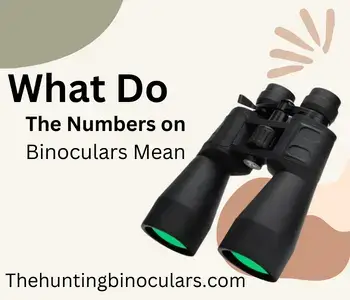
Before using binoculars, you have to know what are binoculars used for is? What do the numbers on binoculars mean OR what does the binoculars number mean? And which binoculars will suit you best? So to get a hold of all these points, we have compiled a great set of words here written below.
In simple words, binoculars are magnification instruments consisting of two telescopes mounted on either a plastic or a metal frame. It is manufactured to ease the viewer to view images or places as if they are very close to them.
Binoculars are designed in such a unique way that they have to be used while held in both hands in place on both eyes. Unlike a monocular or a telescope, in other words, binoculars that are made up of two telescopes give the users a three-dimensional view.
Binocular Numbers Chart
| Binoculars | Magnification | Aperture Size |
| 7×25 | 7x | 25mm |
| 8×42 | 8x | 42mm |
| 10×42 | 10x | 42mm |
| 12×50 | 12x | 50mm |
| 15×56 | 15x | 56mm |
Table of Contents
What Do The Numbers on Binoculars Mean? How It Work
Binoculars are a great optical instrument used to magnify objects that are far away from sight. While hoping to buy good binoculars, some questions arise in the buyers’ minds like how to choose binoculars, how to use them, and what is the meaning of the numbers on binoculars.
The most important of them is understanding binocular numbers and how to use them accurately. So, in this guide, you will find your answer to the question of what does binoculars numbers mean.
The numbers used on the binoculars or the monoculars are used to distinguish one model from the other. Two digits are used—for instance, 14 × 50 mm or 10 × 40 mm.
The first number is referred to for either the magnification, identifying power, or how many times binoculars magnify the image. A 14 × 50 mm binoculars place the image of the object 14 times closer than the original. At the same time, 10 × 40 mm binoculars will have ten times greater power.
The second number, written after x, is written in millimeters and shows the diameter of the objective lens. A 14 x 50 mm binocular has an objective lens of a diameter of 50 mm. At the same time, 10 x 40 mm binoculars have an objective lens of a diameter of 40 mm.

What are The Best Numbers For Binoculars?
Generally, binoculars with a magnification of 6 to 10x are easier to use, but for birdwatching, tracking moving objects, and keeping shaking to a minimum, 8 to 10x magnification is best.
Binocular Magnification
What Is The best magnification for binoculars? Let us take an example of 8×42 mm binoculars to discuss binocular magnification. This thing holds great importance always when asked what do the numbers on binoculars mean. So here, the first number we see shows the magnification capacity.
Binocular magnification is mainly used to refer to the power of binoculars. The ‘X’ you see with the first number, which is eight here, indicates how many times the magnification is. Like here, it is eight times magnified.
Why is magnification necessary? The primary purpose of binoculars is to allow the user to see a distant object in a clear and magnified way. It makes the thing appear more prominent than the original, so you can effectively examine them.
So in the example, we have taken, the binoculars show the object eight times larger than the original object. At the same time, binoculars 8×40, 8×42, 8×70, 8×32, or 8×21 all have the same first number, which shows that they all have the same magnification power.
They all will magnify the object eight times. Similarly, 10×50 binoculars will magnify an object ten times, and 12×60 binoculars will magnify an object twelve times.
What if the number is written in the form 32-150×70? How to read it? This means that these binoculars have a range of magnification capacities from 32 to 150. It means that the binocular magnification can be adjusted anywhere between these numbers.
Newbies commonly make this mistake because they assume that bigger is always better, which is invalid. Binoculars have high resolution, and high magnification is not always best for every user. However, 8x or 10x binoculars are ideal for newbies.
But if they are experienced and eager to discover more and more, then they can most welcome go for binoculars with higher magnifications.

Size Of Objective Lens
We talked about the example 8×42 above. The first number tells about the magnification. So what does the second number mean? The second number, 42, indicates the diameter of the objective lenses in millimeters. Whereas binoculars of 8×21 mm show an objective lens of a diameter of 21 mm, although both have the same eight times magnification.
Why is this important? There are two lenses in the binoculars: the objective lens and the ocular lens. The surface area of the objective lens gets light from the object or the scene and transfers it to the ocular lens, which then transmits the light to the eye.
A larger objective lens captures more light as compared to a smaller one. This makes the object appear brighter and more precise than the original one. If there is low light in the area, more light can be captured for the eye to clarify the image from binoculars. An objective lens of a diameter of 42 mm has four times more surface area than a 21 mm objective lens.
How to get the right balance? If a larger lens gives better quality and brighter images, what is wrong with just getting the most oversized lens? This is not the best thing to do because a bigger lens means an increase in the size of the optical instruments, making them heavier in size and hard to carry around.
Sometimes it is hard to gather light when there is deficient light performance, like in astronomy and stargazing or hunting at night.
In some cases, binoculars can have a lens diameter of up to 100 mm or even more. This means that the binoculars become so large and heavy in size that they cannot be carried around here and there.
So a tripod is needed in this case to hold the binoculars in place. But this is not ideal for people to take it anywhere easily. However, if you need binoculars for such purposes, choose the best binoculars for birding and stargazing.
How To Choose Binoculars
So how to choose the ideal binoculars for yourself? Well, here are some factors which will help you buy the best binoculars for your use.
Price Range
The top-of-the-line binoculars give the best image and magnification but in a durable and affordable package. So before buying binoculars, keep your budget in mind. The binoculars should be an all-rounder.
It should be affordable and have all the desired qualities in it. These days less pricy binoculars having all qualities are being manufactured due to the latest technology.
Pick a Magnification
It is up to the person to choose if he wants to choose 8x or 10x binoculars. In general, both are affordable and have good results. 10x is better for birding and hunting, but it requires a narrow view, a low-light performance, and a more shaky hand. On the other hand, an 8x gives a smaller yet brighter image.
Models
Every binocular user has a way of viewing through binoculars. Everyone has his preferences. Buy a binocular according to your hand size, face size, how you carry it around, how shaky your hands are, and how often you use it.
Check The Eye relief
Most binoculars have eyecups which are handy for people who wear glasses or shades. People who wear glasses or shades should look for binoculars that have durable and adjustable eyecups. This is because when using binoculars, you don’t see black rings around the image.
How To Use Binoculars
It consists of a pair of telescopes made of curved glass lenses and multiple lenses aligned together in the frame to magnify the subject every time you see the image through the set of lenses. But it has a downside that every time this occurs, some light is lost.
Most binoculars utilize prisms that bend and reflect the light as it passes through the objective lens and magnify the image of the object as it passes through the lens frame.
Many binoculars have a focus wheel in the center and a right eye diopter for adjustment near the eyepiece to adjust the strength of the eye to see the magnified image. When looking through the binoculars at an immobilized object about 30-50 feet away, close the right eye and focus using the center wheel. Do this until the image is clear to the left eye and magnified enough.
Once it is apparent to the left eye, close the left one and open the right one. Look at the same target object, make adjustments in the right side diopter, and do not use the center focus wheel unless the image is clear to you. When clear, only use the focus wheel to make further binocular magnification. No additional adjustments need to be made, and you are good to go.
The eyecups, which are the binoculars’ eyepieces, stray from the light that interferes during use. Some binoculars have rubber eyepieces that fold aside, while some can be twisted sideways or up, or downwards.
For your information, we have written a complete guide on different types of binoculars for military use.

Final Verdict
What do the numbers on binoculars mean? This article has given a brief note, and now you know what the numbers exactly mean. The first one indicates the magnification capacity, while the second one shows the diameter of the objective lens. Before shopping for binoculars, you have to know about these optical instruments to get full use of them.
You can experience a great view of the stars with stargazing binoculars. If going for a long journey and exploring nature and birds, go for smaller yet portable binoculars. Keep in mind the magnification capacity of the binoculars as it should not be more than 12x.
Finally, by reading this, you will surely know which binoculars and models will suit you the best, whether for hunting, astronomy, or travel.
Recommended Article!
